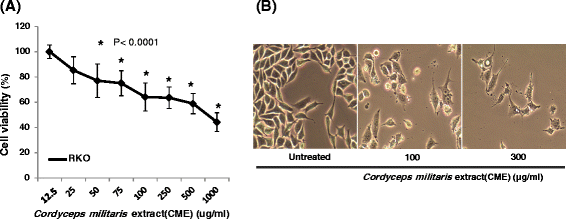Anti-cancer effect of Cordyceps militaris in human colorectal carcinoma RKO cells via cell cycle arrest and mitochondrial apoptosis
- PMID: 26141646
- PMCID: PMC4491205
- DOI: 10.1186/s40199-015-0117-6
Anti-cancer effect of Cordyceps militaris in human colorectal carcinoma RKO cells via cell cycle arrest and mitochondrial apoptosis
Abstract
Background: Cordyceps militaris has been used as a traditional medicine in Asian countries for a long time. Different types of Cordyceps extract were reported to have various pharmacological activities including an anti-cancer effect. We investigated the inhibitory effect of Cordyceps militaris ethanol extract on a human colorectal cancer-derived cell line, RKO.
Methods: RKO cells were treated with various concentrations of nucleosides-enriched ethanol extract of Cordyceps militaris for 48 h and cytotoxicity was measured using a CCK-8 assay. Then, xenograft Balb/c nude mice were injected with RKO cells and subsequently orally administered with ethanol extract of Cordyceps militaris every day for 3 weeks to examine the inhibitory effect on tumor growth. Lastly, the effect of Cordyceps militaris on cell cycle as well as apoptosis was measured using flow cytometry. Also, the expression of p53, caspase 9, cleaved caspase-3, cleaved PARP, Bim, Bax, Bak, and Bad were detected using western blot assay.
Results: RKO cells were highly susceptible to the ethanol extract of Cordyceps militaris (CME) and the growth of RKO cells-derived tumor was significantly delayed by the treatment of Cordyceps militaris. Cordyceps militaris induced cell cycle arrest in G2/M phase (untreated; 20.5 %, CME 100 μg/ml; 61.67 %, CME 300 μg/ml; 66.33 %) and increased early apoptosis (untreated; 1.01 %, CME 100 μg/ml; 8.48 %, CME 300 μg/ml; 18.07 %). The expression of p53, cleaved caspase 9, cleaved caspase-3, cleaved PARP, Bim, Bak, and Bad were upregulated by the treatment of Cordyceps militaris.
Conclusion: Ethanol extract of Cordyceps militaris was highly cytotoxic to human colorectal carcinoma RKO cells and inhibited the growth of tumor in xenograft model. The anti-tumor effect of Cordyceps militaris was associated with an induction of cell cycle arrest and mitochondrial-mediated apoptosis.
Figures





References
-
- Kunjadia PD, Nagee A, Pandya PY, Mukhopadhyaya PN, Sanghvi GV, Dave GS. Medicinal and antimicrobial role of the oyster culinary-medicinal mushroom Pleurotus ostreatus (higher Basidiomycetes) cultivated on banana agrowastes in India. Int J Med Mushrooms. 2014;16:227–38. doi: 10.1615/IntJMedMushr.v16.i3.30. - DOI - PubMed
-
- Phan CW, Lee GS, Macreadie IG, Malek SN, Pamela D. Lipid constituents of the edible mushroom, Pleurotus giganteus demonstrate anti-Candida activity. Nat Prod Commun. 2013;8:1763–5. - PubMed
Publication types
MeSH terms
Substances
LinkOut - more resources
Full Text Sources
Other Literature Sources
Research Materials
Miscellaneous

